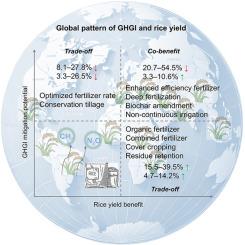以数据为导向的战略,在维持全球水稻生产的同时减轻温室气体排放强度
IF 10.9
1区 环境科学与生态学
Q1 ENGINEERING, ENVIRONMENTAL
引用次数: 0
摘要
温室气体排放强度(GHGI,单位粮食产量二氧化碳当量排放量)是衡量农业生产力和环境风险的整体指标。然而,考虑到不同的管理做法及其空间格局,全球稻田温室气体缓解的潜力仍然知之甚少。在这里,我们使用数据驱动的方法,将站点级观测扩展到全球网格,以量化各种管理实践对GHGI的响应。全球评估表明,10项关键管理措施中有4项,包括增效肥、深度施肥、生物炭改良和不连续灌溉,可使GHGI减少20.7%至54.5%,同时使水稻产量提高3.3%至10.6%。这些效益相当于减少二氧化碳排放1569 - 4.123亿吨,增加水稻产量2580 - 8150万吨。我们的研究结果确定了同时减少温室气体排放和保持水稻产量的关键战略,强调了可持续解决方案在支持气候智能型水稻生产方面的关键作用和巨大潜力。本文章由计算机程序翻译,如有差异,请以英文原文为准。

Data-driven strategies to mitigate greenhouse gas emissions intensity while sustaining global rice production
Greenhouse gas emissions intensity (GHGI, carbon dioxide equivalent emissions per unit grain yield) is a holistic metric to measure agricultural productivity and environmental risks. However, the potential for GHGI mitigation in global rice fields, considering diverse management practices and their spatial patterns, remains poorly understood. Here, using a data-driven approach, we scaled site-level observations to the global grid to quantify GHGI responses to various management practices. Global assessment demonstrated that four out of ten key management practices, including enhanced efficiency fertilizer, deep fertilization, biochar amendment, and non-continuous irrigation, reduced GHGI by 20.7–54.5 % while boosting rice yield by 3.3–10.6 %. These benefits were equivalent to carbon dioxide removal of 156.9–412.3 million tons and additional rice production of 25.8–81.5 million tons. Our findings identify key strategies that simultaneously reduce GHGI and maintain rice yield, highlighting the critical role and vast potential of sustainable solutions in supporting climate-smart rice production.
求助全文
通过发布文献求助,成功后即可免费获取论文全文。
去求助
来源期刊

Resources Conservation and Recycling
环境科学-工程:环境
CiteScore
22.90
自引率
6.10%
发文量
625
审稿时长
23 days
期刊介绍:
The journal Resources, Conservation & Recycling welcomes contributions from research, which consider sustainable management and conservation of resources. The journal prioritizes understanding the transformation processes crucial for transitioning toward more sustainable production and consumption systems. It highlights technological, economic, institutional, and policy aspects related to specific resource management practices such as conservation, recycling, and resource substitution, as well as broader strategies like improving resource productivity and restructuring production and consumption patterns.
Contributions may address regional, national, or international scales and can range from individual resources or technologies to entire sectors or systems. Authors are encouraged to explore scientific and methodological issues alongside practical, environmental, and economic implications. However, manuscripts focusing solely on laboratory experiments without discussing their broader implications will not be considered for publication in the journal.
 求助内容:
求助内容: 应助结果提醒方式:
应助结果提醒方式:


